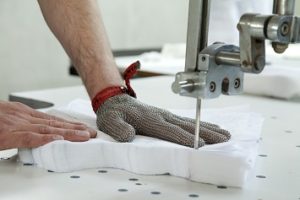In 2016, the American National Standards Institute (ANSI)/International Safety Equipment Association (ISEA) updated its voluntary standard for hand protection, ANSI/ISEA 105. The standard specifies standardized testing methods for U.S. manufacturers to use in classifying protective gloves, rating them on protective factors that include cut, abrasion, and puncture resistance; chemical permeation; and other factors like flame resistance and dexterity.
Europe also updated its voluntary standard, EN 388, in 2016. EN 388 certification is required for gloves that will be sold in Europe. The standard specifies test methods for mechanical hand protection, including abrasion, cut, puncture, and tear resistance. In addition, the updated standard includes test methods and ratings for impact resistance that are required for any gloves that are marketed as “impact resistant.”
The two standards have been, to some extent, harmonized—making selecting gloves for international use moderately easier and addressing some concerns that existed about the EN 388 test methods. Keep reading for a primer on how to decipher mechanical hand protection ratings under both standards.
Cut Resistance Ratings
The major changes to both ANSI/ISEA 105 and EN 388 were to the cut resistance test methods and ratings. The updated ANSI/ISEA standard eliminates one of two test methods that were previously used to measure cut resistance: CPPT machines will be phased out in favor of TDM machines, which use a reciprocating blade to measure cut resistance, using a single method, ASTM F2992-15. The EN 388 standard will also use the TDM machine to rate cut resistance, using the ISO 13997 test method.
The ratings themselves have also been revised and, to a point, standardized. EN 388 measures cut resistance in Newtons of force and classifies cut resistance with letter ratings from A through F. ASTM/ISEA 105 measures cut resistance in units of grams (1 gram is approximately 102 Newtons), and categorizes gloves from A1 through A9. The first six categories, A1 through A6, roughly correspond to the A through F designations used in Europe. Higher ratings (A7 through A9) are used to differentiate cut resistance in higher end gloves.
The different ratings provide cut resistance suited to different uses, as shown below:
| EN 388 Rating | ANSI/ISEA 105 Rating | Use |
| A (≥2 Newtons) | A1 (200–499 grams) | General purpose work glove |
| B (≥5 Newtons) | A2 (500–999 grams) | Light cut hazards (example: automotive work) |
| C (≥10 Newtons) | A3 (1000–1499 grams) | Light/medium cut hazards (example: oil and gas work) |
| D (≥15 Newtons) | A4 (1500–2199 grams) | Medium cut hazards (example: general manufacturing) |
| E (≥22 Newtons) | A5 (2200–2999 grams) | High cut hazards (example: metal fabrication) |
| F (≥30 Newtons) | A6 (3000–3999 grams) | Higher cut hazards (example: metal stamping) |
| A7 (4000–4999 grams) | Highest cut hazards (example: meat processing) | |
| A8 (5000-5999 grams) | Critical cut hazards (example: waste management) | |
| A9 (above 6000 grams) | Extreme cut hazards (example: recycling) |
Tomorrow we’ll take a look at other factors affecting the utility of work gloves.

